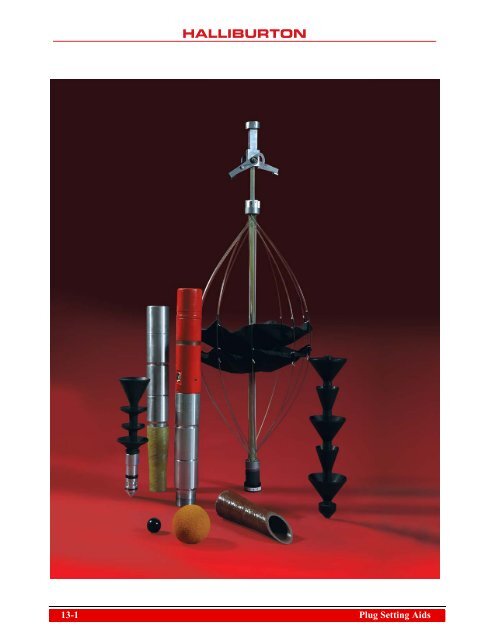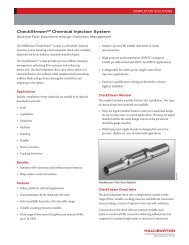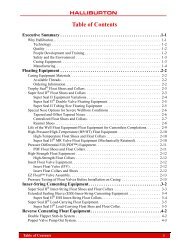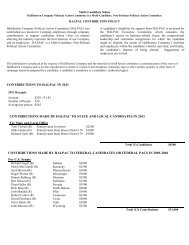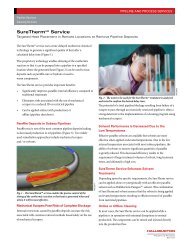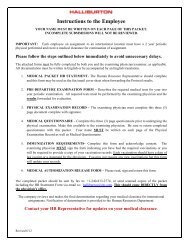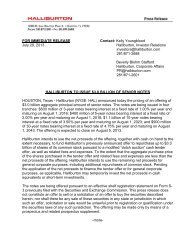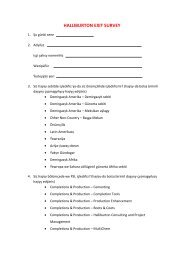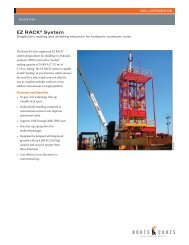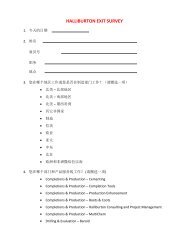Casing Equipment Catalog Sec 13_Foam Wiping ... - Halliburton
Casing Equipment Catalog Sec 13_Foam Wiping ... - Halliburton
Casing Equipment Catalog Sec 13_Foam Wiping ... - Halliburton
Create successful ePaper yourself
Turn your PDF publications into a flip-book with our unique Google optimized e-Paper software.
<strong>13</strong>-1 Plug Setting Aids
Plug Setting Aids<br />
The CST cement support tool, tubing release tool (TRT),<br />
bottomhole kickoff assembly (BHKA) disconnect tool, and<br />
bottomhole kickoff assembly (BHKA) tool system were<br />
designed to aid in setting balanced and competent cement<br />
plugs during remedial and primary cementing operations.<br />
These tools, when used with cementing best practice<br />
applications, can help to improve the attempts to get a proper<br />
Plug Setting Aids Matrix<br />
cement plug set the first time without the need for additional<br />
plugs. These tools are available to order through your nearest<br />
<strong>Halliburton</strong> sales office or field camp. Additional application<br />
information and product data can be supplied upon request.<br />
The following Matrix can help you select which tool can offer<br />
the most benefit for your cement plugging operations.<br />
Plug Setting Aids<br />
Description CST Tool TRT Tool<br />
BHKA<br />
Disconnect<br />
BHKA<br />
Assembly<br />
This tool aids in setting kick off plugs <br />
This tool aids in setting abandonment plugs <br />
This tool aids in setting plugs to help cure lost circulation to continue drilling × × ×<br />
Improves overall success rate of trying to get competent cement plug on first<br />
attempt<br />
Allows the escalated use of more aggressive cement designs due to use of<br />
sacrificial tail pipe<br />
<br />
<br />
Compatible with all known drilling fluids <br />
Allows the setting of an undisturbed plug with a sacrificial tubing tail × <br />
Minimizes risk of differentially sticking work string × <br />
Cement plug can be left drillable with use of this tool ×<br />
Can be used in a lost circulation well environment condition × <br />
Requires the use of an HES tool operator or location supervisor × <br />
Has a diverter tool accessory option *1 <br />
Suitable for use in over 30° to horizontal well conditions × <br />
Ability to set excessive length cement plugs with a non-drillable tail pipe option ×<br />
Option of using drillable or non-drillable tail pipe *2 ×<br />
Creates a false well bottom × × <br />
Helps prevent downhole fluid movement effects × × <br />
Can be rebuilt and reused on location by installing another lower assembly × × ×<br />
Tool contains a tubular fluid retention device × × ×<br />
Tool can be used in a low fluid level well environment × × ×<br />
Torque capable disconnect available × × ×<br />
Aids to support a hydrostatic fluid column × × × <br />
*1 = Unique diverter is required for use with CST<br />
*2 = Drillable and non-drillable tail pipe can be used as long as CST can pass through ID restrictions<br />
© 20<strong>13</strong> <strong>Halliburton</strong>. All Rights Reserved.<br />
Plug Setting Aids <strong>13</strong>-2
Tools for Cased Hole and Openhole Wells<br />
Tool<br />
Specific Tool<br />
Operating Manual/<br />
SAP No.<br />
Cased Hole or<br />
Openhole Well<br />
Maximum<br />
Operating<br />
Temperature<br />
CST Tool 101522810 CH and OH 350°F<br />
TRT Tool 10<strong>13</strong>07421 CH and OH 300°F<br />
Applied<br />
Working<br />
Pressure<br />
Well circulation<br />
pressure<br />
2,500 and<br />
4,000 psi<br />
BHKA Disconnect 101456894 CH and OH 300°F 2,500 psi<br />
BHKA Assembly 101230096 OH 250°F<br />
1,400, 2,200,<br />
and 2,500 psi<br />
Tool Operation Device<br />
Removable disposable<br />
installation tool/ CST tool<br />
displacement dart<br />
Work string foam wiper<br />
ball/ steel activation ball/<br />
pump pressure<br />
Rubber releasing dart/<br />
pump pressure<br />
Inflation opening port<br />
rubber dart/ rubber<br />
releasing dart/ pump<br />
pressure<br />
CST Perigon Cement Support Tool<br />
The CST tool is designed and manufactured by Perigon in<br />
Norway. <strong>Halliburton</strong> is proud to be a distributor for this tool<br />
and its technology. The CST tool is designed to create a<br />
physical barrier between a cement plug and the fluid below<br />
the plug. The purpose of this barrier is to prevent slumping<br />
of the heavier cement into the fluid below the plug. The basic<br />
operation of the CST tool consists of loading the tool inside<br />
the work string at the surface, pumping it down hole with a<br />
dart until it exits the work string and spotting a cement plug<br />
above the tool.<br />
Features<br />
• The CST tool is predominantly made from aluminum<br />
and composites and fabricated in a way that it can be<br />
folded together like an umbrella inside the work string.<br />
• Once exiting the pipe, it will unfold out and fill the hole.<br />
• The membranes will then fill the ID of the hole and help<br />
prevent wellbore fluid below from mixing with the<br />
cement.<br />
• Multiple cement plugs can be set in the wellbore with<br />
multiple CST tools with only one trip in the hole.<br />
• The CST tool can be pumped or placed before the prejob<br />
circulation.<br />
• The dart displaces the CST tool and prevents<br />
contamination in the string.<br />
• No other plug support is required as long as formation<br />
integrity is adequate to support the cement hydrostatic<br />
column, and hole geometry is fairly smooth and within<br />
maximum ID.<br />
HAL25019<br />
CST Tool and<br />
Installation Case<br />
• In horizontal or uphill wellbores, the CST tool can be<br />
placed at TOC to prevent slumping at the top as it also<br />
supports from below.<br />
• The CST is commonly used for off-bottom plug<br />
cementing applications such as plug and abandon,<br />
kickoff, anchor for cased hole whipstock, and other<br />
remedial work.<br />
Optional <strong>Equipment</strong><br />
Placement Dart and<br />
CST Tool Case<br />
• A specially designed diverter tool has been designed and<br />
is currently available to aid in hole cleaning and work in<br />
unison with the installation of the CST tool.<br />
HAL25025<br />
<strong>13</strong>-3 Plug Setting Aids
When to Use the CST Tool<br />
• The CST tool can be used for any off-bottom<br />
plugging operations as long as there is no loss<br />
circulation problem below the tool.<br />
• It can be used in hole sizes up to 45-in. ID.<br />
• It can be placed through restrictions of 2-, 2 1/2-,<br />
and 4-in. ID.<br />
• Inclination from 0° to horizontal and higher if<br />
required.<br />
• No hydrostatic pressure limitation.<br />
• Compatible with all known drilling fluids.<br />
When Not to Use the CST Tool<br />
• When fluid losses below the point where the CST<br />
tool will be placed are experienced.<br />
• If hole size is believed to be larger than 45 in. or<br />
highly irregular, washed out, etc.<br />
• If the whole plug length is to be drilled out (i.e.,<br />
setting the whole cement plug inside casing)<br />
including the CST tool, then special precautions<br />
should be made regarding bit selection.<br />
HAL25018<br />
Optional CST<br />
Plug Setting Diverter<br />
• When there is a combination of 3 1/2-in. drillpipe (DP)<br />
and 6 5/8-in. DP in the same string, a non-standard dart<br />
with a wider working range must be used.<br />
CST transport tube<br />
with CST tool<br />
Drillpipe<br />
Push rod<br />
CST transport tube<br />
Drillpipe<br />
Drillpipe<br />
Rig Floor<br />
Drillpipe<br />
Rig Floor<br />
Cement<br />
Cement<br />
Dart<br />
CST tool<br />
CST tool<br />
CST tool<br />
Figure 1 Figure 2<br />
Figure 3<br />
Figure 4<br />
Figure 1 – Transport Tube Temporarily Installed Inside Drillpipe.<br />
Figure 2 – CST Tool Pushed into Drillpipe from Transport Tool, then Transport Tool Removed.<br />
Figure 3 – CST Tool Circulated into Place ahead of Cement.<br />
Figure 4 – With the CST Tool in Place, Cement can be Placed with a Higher Probability of the Plug Avoiding Contamination or being Disturbed during Initial Set Time.<br />
Plug Setting Aids <strong>13</strong>-4
Tubing Release Tool (TRT)<br />
The purpose of the tubing release tool (TRT) is to enable the<br />
placement of a competent cement plug downhole with a<br />
sacrificial tubing tail. The TRT tool helps ensure a competent<br />
plug on the first attempt for kickoff, side tracking, or plug<br />
and abandonment purposes. The disconnect mechanism's<br />
upper portion, located near the top of cement plug, is made<br />
of non-drillable materials and is retrieved to the surface with<br />
the work string. The TRT tool will also retain the<br />
displacement fluid inside the work string after the separation<br />
of the drillpipe from the lower tubing/tailpipe has occurred.<br />
The release ball prevents displacement fluid from falling<br />
from the work string and mingling with placed cement. The<br />
tubing can be equalized on demand once the drillpipe has<br />
been pulled up a safe distance away from the top of the plug.<br />
Consequently, the cement plug will remain free of damage<br />
and contamination that could be caused by the displacement<br />
fluid falling from the drillpipe ID.<br />
• TRT tool is operated and supplied with two foam wiper<br />
balls to wipe the work string and one steel activation ball to<br />
operate the release mechanism at the disconnect point.<br />
HAL25005<br />
Activation Ball<br />
Features<br />
• This tool features the ability to set longer length cement<br />
plugs without the fear of getting stuck when trying to<br />
pull out. It offers the ability to set more aggressive<br />
(higher amounts of LCM), thixotropic, and faster setting<br />
cement plugs to help cure lost circulation. The sacrificial<br />
tubing tail can be placed directly across, and through, a<br />
loss zone or unstable wellbore area without the fear of<br />
becoming stuck.<br />
• The TRT tool can be used in vertical to highly deviated<br />
wellbores depending on where the tool is placed. This is<br />
a ball activated tool and not recommended for over 30°<br />
deviation placement. Centralizers may be necessary in<br />
large wellbore configurations to help ensure maximum<br />
displacement efficiency and to help hold tubing in place.<br />
• This tool can be extremely useful in a low fluid level well<br />
where calculating displacements to balance a plug can be<br />
difficult. The TRT tool helps ensure accurate<br />
displacements.<br />
• The disconnect mechanism's lower portion is made up of<br />
drillable or non-drillable materials, depending on the<br />
application. This portion of the TRT tool remains<br />
connected to the tailpipe, which remains in the wellbore.<br />
• Sacrificial tailpipe can be aluminum or fiberglass.<br />
• A 3.75-in. OD and a 6-in. OD tool are available to work<br />
with 2 7/8-in., 3 1/2-in., and 4 1/2-in. tubing tails.<br />
TRT Tool<br />
HAL25024<br />
<strong>Foam</strong> Wiper Ball<br />
<strong>13</strong>-5 Plug Setting Aids
Phenolic Ball<br />
Workstring<br />
Nozzle<br />
Top of Loss<br />
Interval<br />
<strong>Foam</strong> Wiper Ball<br />
Borehole Wall<br />
Slurry<br />
<strong>Sec</strong>ondary Releasing<br />
Sleeve<br />
Upper Portion of TRT<br />
Rupture Disc<br />
Top of Cement<br />
Displacement Fluid<br />
<strong>Foam</strong> Wiper Ball<br />
Lower Portion of TRT<br />
Slurry<br />
HAL25020<br />
Tailpipe<br />
HAL25021<br />
Displacing Cement<br />
Landing Activation Ball<br />
Pressure -Drop<br />
Monitor<br />
HAL25022<br />
HAL25023<br />
Release of Tubing Tail<br />
Pulling Above Plug<br />
Plug Setting Aids <strong>13</strong>-6
Bottomhole Kickoff Assembly (BHKA) Disconnect Tool<br />
The primary purpose for the<br />
bottomhole kickoff assembly (BHKA)<br />
disconnect tool is to place a competent<br />
cement plug for kickoff/sidetrack/plug<br />
and abandonment purposes on the<br />
first attempt with the use of a<br />
mechanically operated release device<br />
and a sacrificial tubing tail. This<br />
simplified tool is more economical<br />
and cost effective, but it does not offer<br />
a fluid retention device. It is not<br />
recommended for low fluid level wells<br />
and should be used in a balanced hole<br />
environment.<br />
Features<br />
• The tool features a surface-released,<br />
dart-operated disconnect<br />
mechanism. Placing the release<br />
mechanism near the top of cement<br />
can minimize contamination by<br />
minimizing swabbing of the cement<br />
plug while the work string is pulled<br />
out of the hole.<br />
• The tailpipe remains in the cement<br />
plug to prevent cement<br />
contamination as the work string is<br />
being pulled out of the hole. The<br />
tailpipe length is equal to the length<br />
of the cement plug, less<br />
approximately 20 ft. This tool also<br />
features the ability to set longer<br />
length cement plugs without the<br />
fear of getting stuck when trying to<br />
pull out. It offers the ability to set<br />
more aggressive (higher amounts of<br />
LCM), thixotropic, and faster<br />
setting cement plugs to help cure<br />
lost circulation. The sacrificial<br />
tubing tail can be placed directly<br />
across, and through, a loss zone or<br />
unstable wellbore area without the<br />
fear of becoming stuck.<br />
HAL25015<br />
BHKA Disconnect Tool<br />
HAL25007<br />
BHKA Disconnect Tool<br />
Operating Dart<br />
HAL25009<br />
HAL31404<br />
Bottomhole Kickoff Assembly (BHKA)<br />
Disconnect Operation<br />
Optional BHKA Tool<br />
Diverter Sub<br />
<strong>13</strong>-7 Plug Setting Aids
• This disconnect assembly can be<br />
placed anywhere in the wellbore in<br />
vertical, deviated, and highly<br />
deviated applications.<br />
• Centralizers may be necessary in<br />
large wellbore configurations to<br />
help ensure maximum displacement<br />
efficiency and to help hold tubing in<br />
place.<br />
• 3.75-in., 4.5-in., and 6.75-in. OD<br />
tools are available to work with <br />
2 7/8-in., 3 1/2-in., and 4 1/2-in.<br />
tubing tails. Sacrificial tailpipes can<br />
be aluminum or fiberglass.<br />
Optional <strong>Equipment</strong><br />
• A specially designed diverter tool is<br />
currently available to aid in hole<br />
cleaning and work in unison with<br />
the BHKA disconnect tool.<br />
Release<br />
(disconnect)<br />
mechanism<br />
Tailpipe<br />
Diverter sub<br />
Drillpipe/<br />
Workstring<br />
TOC<br />
Releasing<br />
dart<br />
HAL25011<br />
BHKA Disconnect Tool<br />
After Release<br />
Plug Set with BHKA<br />
Disconnect Tool<br />
HAL31494<br />
Quality Control Process of Verifying Bulk Cement Delivery to the Wellsite<br />
Plug Setting Aids <strong>13</strong>-8
BHKA-Disconnect Torque-Capable Assembly<br />
Features<br />
A BHKA-disconnect torque-capable<br />
assembly is available for when pipe<br />
rotation is desired during circulation<br />
and cementing with the use of<br />
sacrificial tubing technology.<br />
This tool is designed for use with steel<br />
or aluminum sacrificial tubing. This<br />
disconnect is available in different<br />
tubing and tool size configurations and<br />
rated to handle tensile loadings from<br />
sacrificial tubing up to 100,000 lb.<br />
These torque capable tools have a<br />
torque rating from 6,300 up to 30,000 <br />
ft/lb. depending on tubing and tool<br />
sizes.<br />
BHKA-Disconnect Torque-Capable Assembly<br />
Releasing sleeve<br />
Thread protector<br />
Shear pins<br />
Coupling<br />
Tailpipe thread<br />
Tool<br />
OD<br />
Releasing<br />
Sleeve<br />
ID<br />
Collet<br />
Collet retainer<br />
<strong>13</strong>-9 Plug Setting Aids
Bottomhole Kickoff Assembly (BHKA) Tool<br />
The bottomhole kickoff assembly tool was designed as a<br />
premium method to get a competent cement plug set in a<br />
wellbore environment where setting a successful plug on the<br />
first attempt could be questionable. It is designed to help<br />
secure a bottom floor in order to support the base of the<br />
cement plug. This tool can be used for kickoff/sidetrack/plug<br />
and abandonment purposes. It is mechanically operated by<br />
wiper darts released from surface. This tool system utilizes<br />
the BHKA disconnect tool, an aluminum sacrificial tubing<br />
tail, an inflatable packer, and a diverter sub to help create a<br />
favorable well condition for successful plug cementing<br />
operations.<br />
• This tool is available in the following sizes:<br />
• 4 /12-in. OD tool.<br />
– Fits 5 1/2- to 8-in. hole.<br />
• 5 9/16-in. OD tool.<br />
– Fits 6 1/2- to 10 1/2-in. hole.<br />
• 10 1/4-in. tool.<br />
– Fits 10 1/2- to 15 1/2-in. hole.<br />
Features<br />
This tool system features four major components:<br />
• The BHKA disconnect tool located at the top of the<br />
cement plug:<br />
– Cement contamination is minimized by placing the<br />
release mechanism near the TOC. This minimizes<br />
swabbing the cement plug while pulling the work string<br />
out of the hole.<br />
• Drillable or non-drillable tailpipe:<br />
– This drillable tailpipe remains in the cement plug to<br />
prevent cement contamination as the work string is<br />
being pulled out of the hole. The aluminum or steel<br />
tailpipe length is equal to the length of the cement plug<br />
less 20 ft. Tailpipe is not included with tool assembly.<br />
• Inflatable packer element:<br />
– The inflatable packer element creates a false bottom to<br />
prevent cement movement. It also seals the formation<br />
from gas or water migration. This portion of the tool<br />
system is not drillable.<br />
• Diverter sub:<br />
– Located at the bottom of the sacrificial tubing. This<br />
allows the wellbore to be washed from top to bottom at<br />
the location the cement plug is to be placed across.<br />
• The tool operates with two surface released darts.<br />
• This system can be used in vertical, deviated, and highly<br />
deviated applications.<br />
• This plug setting aid system helps reduce detrimental<br />
effects of fluid extrusion, spiral flow contamination, and<br />
boycott effects.<br />
• Centralizers may be necessary in larger wellbore<br />
configurations.<br />
HAL250<strong>13</strong><br />
Tubing Release<br />
Dart<br />
HAL25014<br />
Inflation and Port<br />
Opening Dart<br />
Plug Setting Aids <strong>13</strong>-10
Basic Job Operations<br />
• Run in hole with tool assemblies.<br />
• Wash the wellbore across the plug setting area with<br />
diverter tool.<br />
• Launch the inflation and port opening dart and inflate<br />
the packer.<br />
• Establish circulation above the packer.<br />
• Place cement plug in the wellbore to the top of<br />
disconnect assembly.<br />
• Launch releasing dart and pump displacement as<br />
required.<br />
• Land dart and pressure up to activate release mechanism.<br />
• Release from tubing and pull above the plug or out of <br />
the hole.<br />
Drillpipe/workstring<br />
BHKA<br />
Disconnect<br />
TOC<br />
Releasing dart<br />
Drillable<br />
Tail Pipe<br />
Inflatable<br />
Packer<br />
Inflation port<br />
opening dart<br />
BHKA<br />
Diverter<br />
Sub<br />
HAL25010<br />
BHKA Tool in<br />
Wellbore<br />
HAL25012<br />
BHKA Tool After Cementing<br />
<strong>13</strong>-11 Plug Setting Aids
Plug Setting Aid System<br />
The plug setting aid system combines the field proven BHKA<br />
disconnect assembly and sacrificial tubing plug cementing<br />
operations with two new products: the drillable tail pipe<br />
centralizer and the centralizer diverter shoe. These items,<br />
when used together, help with setting a competent cement<br />
plug in vertical, inclined, and horizontal wellbore conditions.<br />
The drillable centralizer and centralizer diverter shoe help<br />
centralize the sacrificial tubing by incorporating multiple<br />
layers of flexible fabric belt diffusers that also direct the flow<br />
of cement into the sacrificial tubing and wellbore annulus.<br />
The diffusers are fully adjustable in size and flow pattern to<br />
allow the “trapping” of a cement plug between the top of the<br />
diverter shoe through the centralizers and up to the BHKA<br />
disconnect tool. All of these items can be used together as a<br />
system or separately to enhance cement plug setting<br />
operations.<br />
Drillable Tailpipe<br />
Diverter<br />
Drillable Tailpipe<br />
Centralizer<br />
Basic Operation of the PSA Concept<br />
• Install centralized diverter shoe on end of tubing.<br />
• Run the plug-setting tubing string to bottom.<br />
• Sacrificial tubing string installed from bottom of where<br />
cement plug is to be placed, up to desired top of cement<br />
(TOC) and the tubing release point.<br />
• TOC point to include another drillable centralizer.<br />
– Note: Additional drillable tubing centralizers can be<br />
used if required.<br />
• BHKA-disconnect tool installed on top of upper most<br />
drillable centralizer.<br />
• Run in hole with standard retrievable work string tubing<br />
to surface.<br />
• Use <strong>Halliburton</strong> dart/ball-drop cementing head.<br />
• While circulating, drop the diverter ball to activate the<br />
drillable diverter and circulate clean the interval where<br />
the cement plug will be set.<br />
• Set the cement plug with the option of using a more<br />
aggressive cement design because the tubing string will<br />
not be removed.<br />
– Higher viscosity/density.<br />
– Faster set/gelling time.<br />
– Higher lost circulation material (LCM) concentrations.<br />
• Release displacement dart from surface and displace to<br />
balance plug as calculated and until dart lands.<br />
• Pressure up on tubing string and activate the disconnect,<br />
then pull tubing up above top of plug for reverse out<br />
option, or pull out of hole as pre-determined.<br />
Top View of Drillable Tailpipe Diverter and Centralizer<br />
Plug Setting Aids <strong>13</strong>-12
Drillable Centralizer and Diverter Shoe Features and<br />
Benefits<br />
• Helps centralize the sacrificial tubing in the wellbore.<br />
• Improves mud displacement and cement slurry<br />
placement.<br />
• Helps keep sacrificial falling through light weight cement<br />
plugs after disconnect.<br />
Drillable Diverter Shoe Features and Benefits<br />
• Guides tail pipe into wellbore with elastomeric<br />
centralizer.<br />
• Centralizer assembly on shoe allows one way fluid<br />
movement.<br />
• Provides jetting action for hole cleaning and cement<br />
placement.<br />
• Provides base to eliminate annular fluid movement<br />
caused by gravity.<br />
• Mitigates annular fluid movement after slurry<br />
placement.<br />
• Prevents slumping in horizontal wells.<br />
Sizes Available<br />
• The current sizes available for the centralizer and<br />
diverter shoe are 2 7/8- and 3 1/2-in.<br />
– Note: Other sizes can be considered for design upon<br />
request.<br />
• The drillable tail pipe centralizer incorporates multiple<br />
layers of fabric belting that can be configured for<br />
multiple hole diameters.<br />
• The flexible fabric layers allow the assembly to be<br />
configured with a variety of annular flow path options.<br />
• The configuration can be optimized for particular<br />
cementing operations to be performed.<br />
• Configuration options include optimization of blade<br />
centralizer ring OD, annular flow shape, and stiffness.<br />
<strong>13</strong>-<strong>13</strong> Plug Setting Aids
PSA System used in Vertical Well Application<br />
PSA System used in Deviated Well Application<br />
Plug Setting Aids <strong>13</strong>-14


